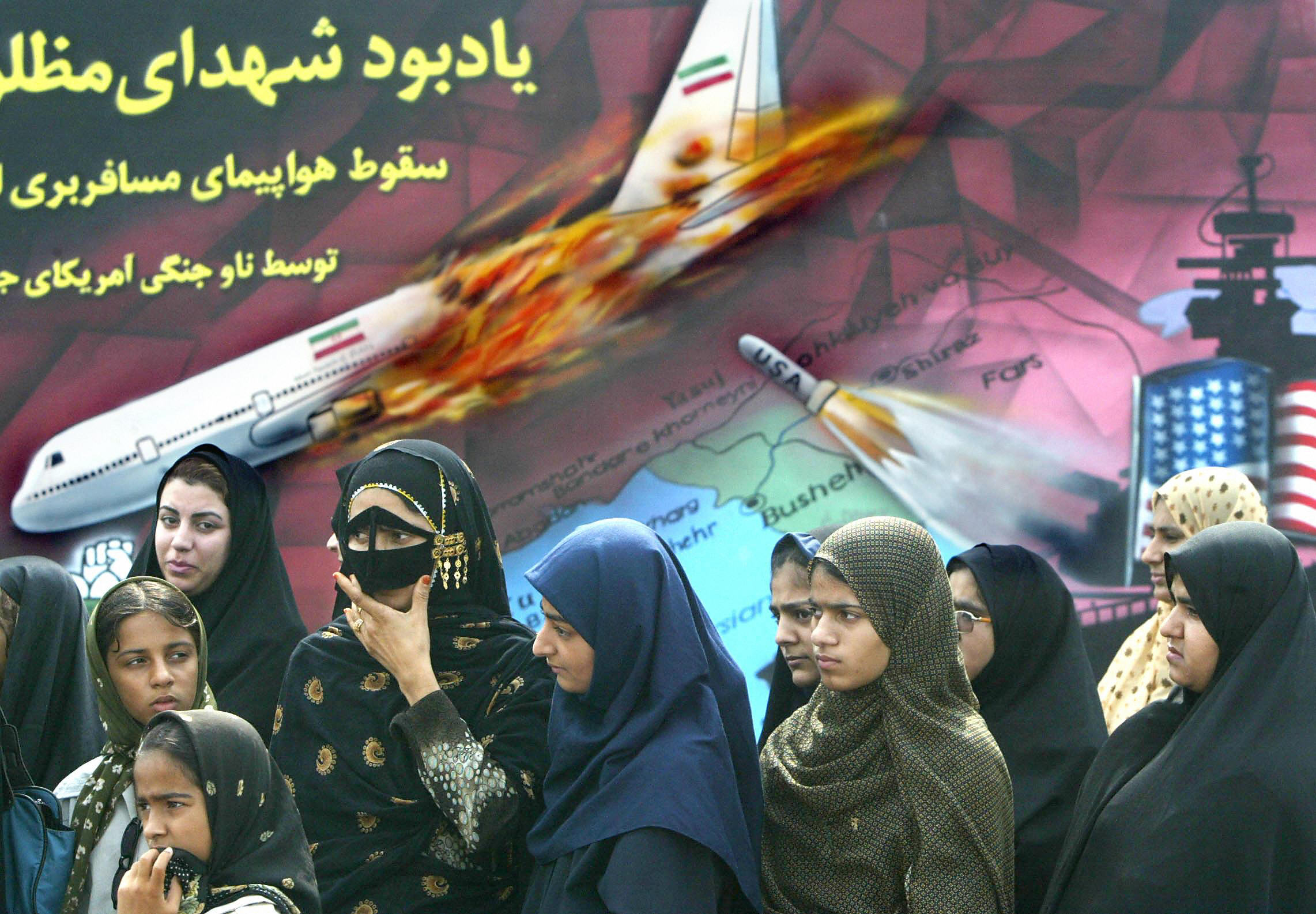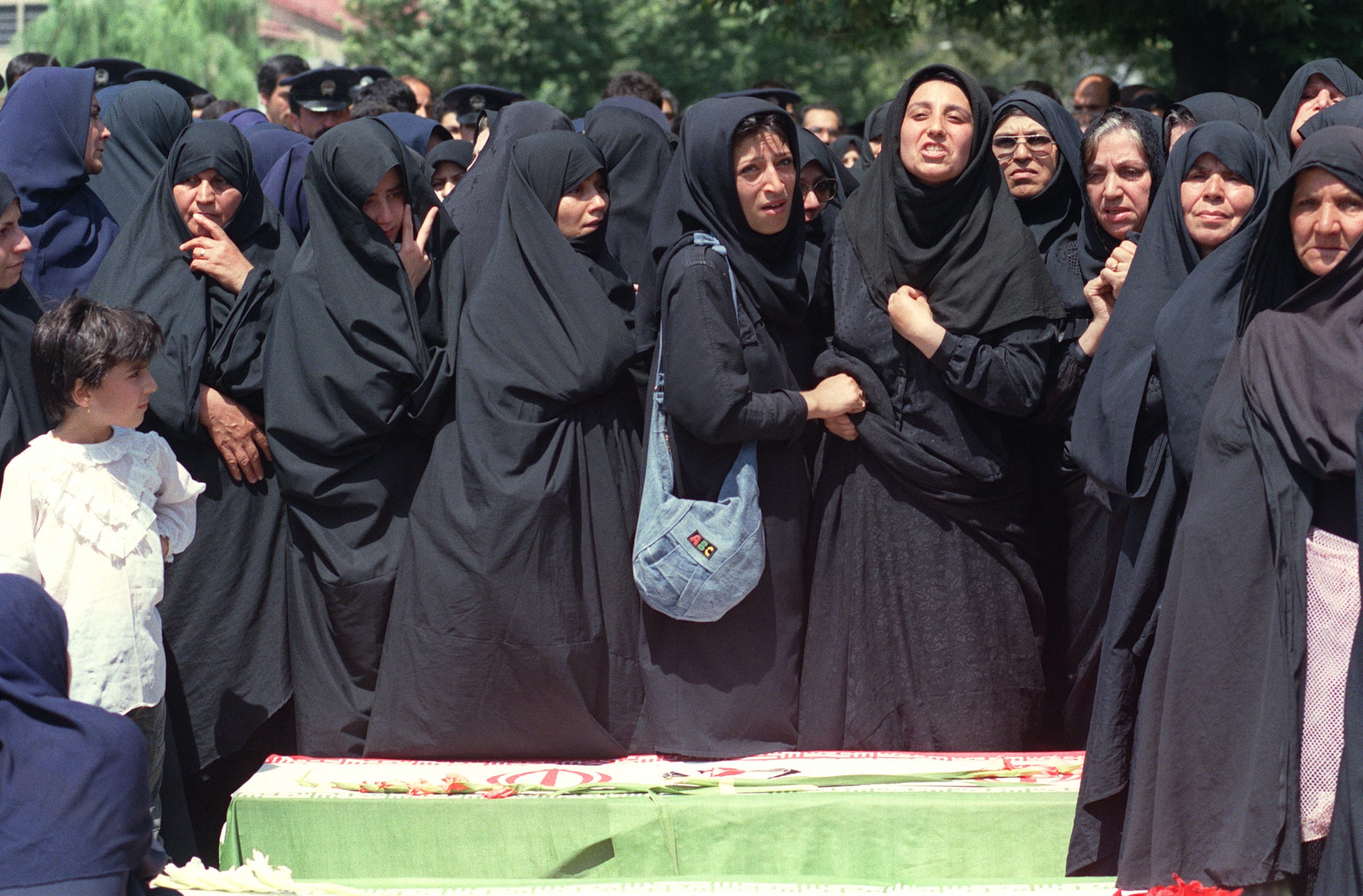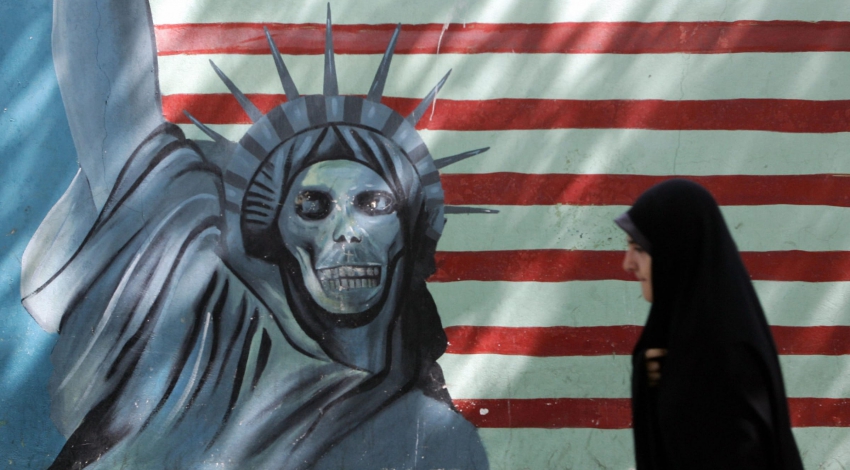The crew of the USS Vincennes, skirmishing with Iranian gunboats inside Iranian territorial waters, had somehow concluded that Iran Air 655, an Airbus A300, was really an old F-14 fighter plane.
By the time I got to the makeshift morgue in a cold storage warehouse at the Iranian port of Bandar Abbas, three days after the incident, about 170 bodies had been recovered. Iranian officials thoughtfully unrolled handfuls of toilet paper for reporters to hold over their noses.
As I wrote at that time, �The corpses were twisted, bloated; some had been chewed, some dismembered. Ice had crystallized across their features, man-made hoar-frost settling over hair and lashes. Many had been found nude, their clothing stripped from them by the blast and the rush of air as they fell 12,000 feet into the strait.� Those had been covered with blankets. �Many were mutilated beyond recognition. In some cases whole families were wiped out, and no one came looking for them.� About 40 had not been identified. Those who had been had their names and ages pinned on them.
[caption id="" align="alignnone" width="790"]
 Relatives of victims of the Iranian Airbus shot down by the US Navy cruiser USS Vincennes in 1988 stand under a painting depicting the scene. STF/AFP/Getty[/caption]
Relatives of victims of the Iranian Airbus shot down by the US Navy cruiser USS Vincennes in 1988 stand under a painting depicting the scene. STF/AFP/Getty[/caption]Some of the dead, to my surprise, seemed at peace. Twenty-year-old Fatima Faidazaida had been found in the water there hours after the crash still clutching her baby. They were together now in the same coffin.
And then there was Leila Behbahani, the little girl I could not forget�I think none of the reporters there could forget her. She was 3 years old, �still dressed in her tidy blue dress, black shoes, white socks and little gold bangles on her wrist.�
A couple of days later, at a press conference in Tehran, a contentious BBC reporter tried to get an Iranian air force brigadier general to say he thought the Americans shot down the airliner on purpose: �Don�t you think the Americans meant to do it?�
�No,� said the officer, �I think they did not care enough to be careful enough not to do it.�
Now, after more than three decades, we find ourselves once again approaching undeclared war with Iran, and as the conflict develops it is much more likely to resemble the long-forgotten adventure in the 1980s than the outright invasion of neighboring Iraq in 2003.
Will we care enough to be careful enough not to commit atrocities? Indeed, will we be careful enough not to launch a war out of anyone�s control?
Iran is now an old enemy, and has learned a lot about the United States. But it is not clear how much the Americans, especially those in the current administration, have learned about Iran.
We see certain patterns repeating themselves, a kind of geopolitical whiplash as fuck-ups in one part of the world lead to further fuck-ups elsewhere when the United States scrambles to regain its footing and restore its prestige.
In 1987, the Reagan administration, unofficially but unmistakably, joined the war against Iran that had been launched in 1980 by the Iraqi tyrant Saddam Hussein. (Yes, that Saddam Hussein.)
The American action followed on a series of humiliations at the hands of the ayatollahs and their proxies: the overthrow of the Shah of Iran, who was a long-time American client and sometime ally; the Tehran embassy hostage crisis of 1979-1981; the suicide bombing of the U.S. Marine barracks in Beirut in 1982; devastating attacks on the old U.S. embassy in Lebanon in 1983 and a new temporary embassy in 1984. A growing number of American, British, and other Western hostages were kidnapped by Iran�s agents, including the CIA station chief William Buckley. In 1985, a U.S. airliner was hijacked; an American sailor on board was murdered.
Iran is now an old enemy, and has learned a lot about the United States. But it is not clear how much the Americans, especially those in the current administration, have learned about Iran.
Thanks to the machinations of the Iranians and their Syrian allies, the American effort to stabilize Lebanon in the wake of Israel�s 1982 invasion collapsed, and many American allies in the Middle East figured Reagan had become an unreliable partner. The Saudis were especially worried.
So the Reagan administration began looking for ways to make convincing shows of force. Reagan bombed Libya in 1986 and claimed its leader Muammar Gaddafi was intimidated. (In fact he launched a wide-ranging terrorist campaign. He even supplied the Irish Republican Army with a huge arsenal to punish Britain for letting the attack planes fly out of its bases.)
Meanwhile National Security Council staffers, including Oliver North, late of the National Rifle Association, tried to fund a covert guerrilla army in Nicaragua in defiance of a congressional ban. The money would come from selling U.S. arms to Iran and some of the hostages would be released into the bargain. It was a plot so improbable and poorly executed that, once revealed, it blew up into what was known as the Iran-Contra scandal.
Now the Reagan administration, humiliated by its own inept dealings with Iran, set out to teach the mullahs a lesson while supporting their mortal enemy, Saddam Hussein.
In 1987 �Operation Earnest Will� started with a thin ruse, putting American flags and names on Kuwaiti tankers carrying oil for Saddam. Oil was, of course, the lifeblood of his war effort. To protect the ships, the Americans deployed huge convoys in the Persian Gulf, reportedly the biggest they�d put to sea since World War II.
If Iran challenged the American flag, the U.S. military would impose what it likes to call a �proportional response.� Thus an ostensibly defensive operation was meant to intimidate offensively, a little like poking a bear in a cage, waiting for it to react. The tactic may sound familiar to people following today�s events in the region with the deployment of the USS Abraham Lincoln.
The Iranian answer in 1987 came in the form of naval mines dropped into the waters of the gulf and the Strait of Hormuz that connects the gulf to the rest of the world.
The confrontation escalated quickly: the U.S. attacked Iranian oil derricks, and skirmishes began with Iranian warships, especially fast-moving patrol boats of the kind that engaged the Vincennes about the time it shot down Iran Air 655. In Washington, collateral casualties like 3-year-old Leila were not seen and little remarked upon.
[caption id="" align="alignnone" width="803"]
 Iranian women stand over the coffins of those who died when an Iran Air passenger jet was shot down over the Gulf in 1988. Norbert Schiller/AFP/Getty[/caption]
Iranian women stand over the coffins of those who died when an Iran Air passenger jet was shot down over the Gulf in 1988. Norbert Schiller/AFP/Getty[/caption]�The navy's most expensive surface warship, designed to track and shoot down as many as 200 incoming missiles at once, had blown apart an innocent civilian airliner in its first time in combat,� Newsweek and Frontline reported in 1992 after an exhaustive investigation. They had learned �the Vincennes was inside Iranian territorial waters at the time of the shoot-down�in clear violation of international law. The top Pentagon brass understood from the beginning that if the whole truth about the Vincennes came out, it would mean months of humiliating headlines. So the U.S. Navy did what all navies do after terrible blunders at sea: it told lies and handed out medals.�
The war ended a few months later when Iran, exhausted after eight years of combat with Iraq, and now facing the American threat as well, decided to accept a ceasefire. But that was a short-lived victory for the U.S. Less than two years later, erstwhile ally Saddam invaded erstwhile ally Kuwait. The U.S. went to war to drive him out, but then he lingered in power in Baghdad for another dozen years.
Significantly, two important figures in the Trump administration played roles in that cynical and confused bit of history. National Security Adviser John Bolton, an assistant attorney general under Reagan, argued against a special counsel to investigate Iran-Contra. And Elliott Abrams, now special envoy for Venezuela (another Trump target), lied to Congress twice about the Iran-Contra coverup.
Both men strongly supported the 2003 invasion of Iraq to oust Saddam Hussein. Then, as we know, Washington�s clumsy efforts to stabilize the country proved even more lengthy, costly, and bloody than Reagan�s Lebanon adventure. Ironically but predictably, next door neighbor Iran also became the dominant foreign power in Baghdad.
omeone else who lived all that history is a friend of mine who is intimately familiar with the way the American generals have planned for conflicts with Iran�s Revolutionary Guard Corps, the largest and most powerful component of Iran�s military, which the Trump administration recently declared a terrorist organization.
U.S. Central Command, based in Florida but responsible for the Middle East, has loved to plan against Iran because it is so capable�such a worthy enemy in military terms. But, as my friend cautioned, �none of the planning ever ended well.� At a strategic level �there were no happy endings, no good outcomes, just more questionable assumptions and unknowns.�
As a result, according to my friend, �the favored scenario was proportional response, because that could be a controlled situation. Anything else could get out of control and no one could say where it would lead.�
Some politicians like to think the Iranian government is ripe for regime change�especially those like Bolton and Trump lawyer Rudy Giuliani who have given numerous speeches to support the formerly terrorist-designated and still cult-like Mujahedin e Khalq (MEK) organization, which used to be sponsored by Saddam.
Among many of those in uniform, there used to be a feeling that the Obama administration�s nuclear agreement with Iran, which Trump reneged on and has tried to destroy, somehow tied their hands, that �it was a super-bad deal�that Trump was somehow the �new sheriff.��
But even the hawks in the military are skeptical about bringing down the regime. According to my friend, scenarios center on the notion that Iran can be forced not only to change its behavior, the unlikely outcome Bolton suggests, but �given a bloody nose� in retribution for its role killing American soldiers in Iraq in years past.
Indeed, that notion of the bloody nose may be what�s really at the heart of today�s heightened confrontation with Iran. If regime change is implausible, and behavior modification is unlikely, that�s about all that�s left.
But wars, whether declared or undeclared, are not about bloody noses.
At the end of the day they are about little girls in fiberboard coffins.











